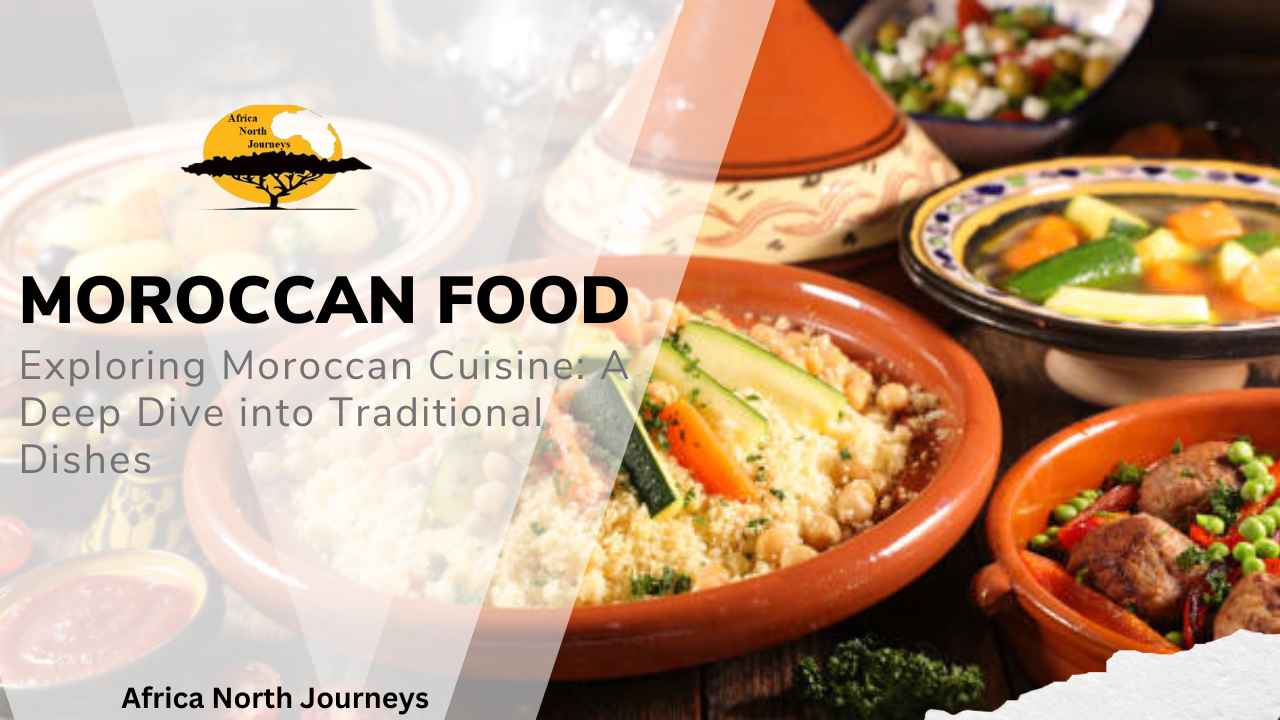Dishes from Morocco

Africa North Journeys
Moroccan cuisine is a rich and vibrant tapestry of flavors, colors, and textures that reflect the country’s diverse cultural heritage and history. Drawing influences from Berber, Arab, Andalusian, and French cuisines, Moroccan dishes are known for their aromatic spices, fresh ingredients, and intricate preparation methods. This detailed exploration delves into some of the most iconic and beloved dishes from Morocco, offering a comprehensive look at their ingredients, preparation, and cultural significance.
Dishes from Morocco
Tagine, named after the conical clay pot in which it is cooked, is perhaps the most iconic Moroccan dish. This slow-cooked stew can be made with a variety of ingredients, including meats, poultry, seafood, and vegetables, all simmered with a blend of aromatic spices.
A traditional meat tagine often features lamb or chicken, cooked with ingredients such as preserved lemons, olives, onions, and a mix of spices like cumin, coriander, ginger, saffron, and cinnamon. Vegetables like carrots, potatoes, and tomatoes are commonly added, creating a hearty and flavorful dish. The unique shape of the tagine pot allows steam to rise, condense, and drip back down, ensuring the ingredients remain moist and tender.
Tagines are not just meals but a central part of Moroccan social life. They are often served communally, with family and friends gathered around, using bread to scoop up the rich, flavorful stew. Tagines are enjoyed during regular family dinners as well as special occasions and celebrations.
Dishes from Morocco
Couscous, often referred to as the national dish of Morocco, is a versatile and essential component of Moroccan cuisine. It consists of tiny steamed balls of semolina wheat, often served with meat and vegetable stews.
The process of making couscous is labor-intensive, traditionally involving hand-rolling semolina grains with water to form small granules. These granules are then steamed multiple times, resulting in a light and fluffy texture. Couscous is usually served with a stew of lamb, chicken, or beef, accompanied by vegetables such as carrots, zucchini, chickpeas, and onions. A variety of spices, including saffron, turmeric, and cinnamon, are used to enhance the dish’s flavor.
Couscous holds a special place in Moroccan culture, often served on Fridays, the holy day of the week, and during festive occasions like weddings and family gatherings. It symbolizes abundance, hospitality, and community.
Dishes from Morocco
Pastilla (also known as bastilla or b’stilla) is a unique Moroccan dish that combines sweet and savory flavors in a flaky pastry. Traditionally made with pigeon, but often substituted with chicken, pastilla is a showcase of Moroccan culinary artistry.
The filling of a pastilla includes shredded meat cooked with onions, spices (cinnamon, saffron, and ginger), and almonds, all encased in layers of warqa pastry (similar to phyllo dough). The top is sprinkled with powdered sugar and cinnamon, creating a striking contrast between the sweet and savory elements. The preparation involves multiple steps, including slow-cooking the meat, layering the pastry, and baking it to golden perfection.
Pastilla is often reserved for special occasions and celebrations, such as weddings and religious festivals. Its elaborate preparation and presentation make it a symbol of Moroccan hospitality and culinary sophistication.
Dishes from Morocco
Harira is a traditional Moroccan soup, particularly popular during Ramadan, when it is served to break the fast. This hearty soup is rich in flavor and nutrients, making it a staple in Moroccan households.
Harira is made with tomatoes, lentils, chickpeas, and a variety of herbs and spices, including cilantro, parsley, ginger, and cinnamon. It is often thickened with a mixture of flour and water and can include meat such as lamb or beef. The soup is simmered slowly, allowing the flavors to meld together, resulting in a comforting and nourishing dish.
Harira is more than just a soup; it is a comforting ritual during Ramadan and is also enjoyed throughout the year. It represents warmth, home, and the communal spirit of Moroccan dining.
Dishes from Morocco
Rfissa is a traditional Moroccan dish often prepared for special occasions, such as the celebration of a newborn or a family gathering. It features layers of shredded msemen (a type of Moroccan flatbread) soaked in a flavorful broth.
The broth is made with chicken, lentils, onions, and a blend of spices, including fenugreek, saffron, ginger, and ras el hanout. The msemen absorbs the broth, becoming tender and rich with flavor. Rfissa is typically served in large communal platters, with the chicken placed on top of the bread layers.
Rfissa is deeply rooted in Moroccan tradition, symbolizing generosity and celebration. It is a dish that brings families together, emphasizing the importance of shared meals and hospitality.
Dishes from Morocco
Mechoui is a Moroccan dish of roasted lamb or beef, often prepared for large gatherings and festive occasions. The meat is typically slow-roasted to perfection, resulting in a tender and flavorful dish.
Whole lamb or large cuts of beef are seasoned with a mixture of spices, including cumin, coriander, and paprika. The meat is then roasted, either in a traditional clay oven or over an open fire, until it is tender and juicy. The result is a succulent dish with a smoky, aromatic flavor.
Mechoui is a celebratory dish, commonly served at weddings, feasts, and religious holidays. It embodies the spirit of Moroccan hospitality and the communal enjoyment of food.
Dishes from Morocco
Zaalouk is a popular Moroccan salad made from cooked eggplants and tomatoes, seasoned with garlic, olive oil, and spices. It is often served as a side dish or appetizer.
Eggplants are roasted or grilled until tender, then mashed with tomatoes, garlic, and a blend of spices such as cumin, paprika, and chili. The mixture is cooked slowly, allowing the flavors to meld together. Zaalouk can be served warm or cold, often accompanied by bread.
Zaalouk is a staple in Moroccan cuisine, reflecting the country’s love for fresh vegetables and bold flavors. It is commonly found on the Moroccan table, showcasing the simplicity and richness of the local ingredients.
Dishes from Morocco
Briouats are small Moroccan pastries filled with a variety of sweet or savory fillings, wrapped in thin pastry dough, and fried to golden perfection. They are enjoyed as snacks, appetizers, or desserts.
Savory briouats can be filled with minced meat, chicken, cheese, or seafood, mixed with spices like cinnamon, ginger, and coriander. Sweet briouats often contain almond paste flavored with orange blossom water and cinnamon. The filled pastry triangles are fried until crispy and golden.
Briouats are versatile and can be found in both everyday meals and festive occasions. They represent the creativity and diversity of Moroccan cuisine, offering a delightful combination of textures and flavors.
Dishes from Morocco
Makouda are Moroccan potato cakes, crispy on the outside and soft on the inside, often enjoyed as street food or appetizers.
Mashed potatoes are mixed with spices like cumin, paprika, and garlic, formed into small patties, and then fried until golden brown. They are typically served with a spicy harissa sauce or stuffed into bread for a satisfying snack.
Makouda is a popular street food in Morocco, reflecting the country’s love for simple yet flavorful snacks. They are enjoyed by people of all ages and are a common sight in markets and food stalls.
Dishes from Morocco
Kefta refers to Moroccan spiced meatballs, usually made from ground beef or lamb, mixed with herbs and spices, and either grilled or cooked in a tomato sauce.
The meat is mixed with chopped onions, parsley, cilantro, and spices such as cumin, paprika, and cinnamon. The mixture is shaped into small balls or patties and cooked in various ways. Kefta can be grilled on skewers, cooked in a tagine with tomatoes, or served as a filling for sandwiches.
Kefta is a versatile and beloved dish in Moroccan cuisine, enjoyed in various forms across the country. It is a testament to the Moroccan mastery of spices and the ability to create delicious meals from simple ingredients.
Dishes from Morocco
Chebakia is a traditional Moroccan pastry, especially popular during Ramadan. These honey-soaked sesame cookies are a sweet treat that embodies the spirit of Moroccan festivities.
The dough is made from flour, sesame seeds, anise, and orange blossom water, shaped into intricate flower-like forms, and then fried until golden. The fried cookies are soaked in honey and sprinkled with sesame seeds.
Chebakia is synonymous with Ramadan, enjoyed to break the fast alongside harira soup. It symbolizes the sweetness of celebration and the joy of communal meals.
Dishes from Morocco
Sfenj are Moroccan doughnuts, crispy on the outside and soft on the inside, often enjoyed as a breakfast treat or snack.
The dough is made from flour, yeast, salt, and water, shaped into rings, and fried until golden brown. Sfenj are typically dusted with sugar or dipped in honey.
Sfenj is a popular street food, enjoyed by Moroccans of all ages. They are a common sight in markets and bakeries, reflecting the country’s love for simple and satisfying snacks.
Moroccan cuisine is a reflection of the country’s rich history, diverse cultures, and vibrant traditions. From the hearty tagine and the celebratory couscous to the sweet delights of chebakia and sfenj, Moroccan dishes offer a culinary journey that is both exotic and comforting. Each dish tells a story, bringing together ingredients, techniques, and flavors that have been passed down through generations. Whether you are exploring the bustling markets of Marrakech, enjoying a family meal in Fez, or savoring street food in Casablanca, Moroccan cuisine offers an unforgettable experience that delights the senses and nourishes the soul.
Casablanca Tours:
Tangier Tours:

